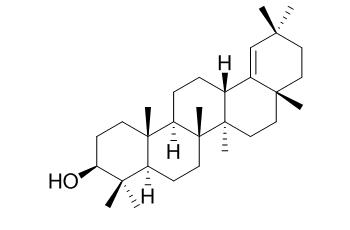Germanicol
Germanicol induces selective growth inhibitory effects in human colon HCT-116 and HT29 cancer cells through induction of apoptosis, cell cycle arrest and inhibition of cell migration. Germanicol may have anti-inflammatory effects .
Inquire / Order:
manager@chemfaces.com
Technical Inquiries:
service@chemfaces.com
Tel:
+86-27-84237783
Fax:
+86-27-84254680
Address:
1 Building, No. 83, CheCheng Rd., Wuhan Economic and Technological Development Zone, Wuhan, Hubei 430056, PRC
Providing storage is as stated on the product vial and the vial is kept tightly sealed, the product can be stored for up to
24 months(2-8C).
Wherever possible, you should prepare and use solutions on the same day. However, if you need to make up stock solutions in advance, we recommend that you store the solution as aliquots in tightly sealed vials at -20C. Generally, these will be useable for up to two weeks. Before use, and prior to opening the vial we recommend that you allow your product to equilibrate to room temperature for at least 1 hour.
Need more advice on solubility, usage and handling? Please email to: service@chemfaces.com
The packaging of the product may have turned upside down during transportation, resulting in the natural compounds adhering to the neck or cap of the vial. take the vial out of its packaging and gently shake to let the compounds fall to the bottom of the vial. for liquid products, centrifuge at 200-500 RPM to gather the liquid at the bottom of the vial. try to avoid loss or contamination during handling.
Appl. Sci.2023, 13(2), 860.
Biocell2023, 47(8):1793-1802
J Chromatogr A.2022, 1685:463640.
Front Mol Neurosci.2023, 15:1083189.
Molecules.2019, 24(11):E2044
J Ethnopharmacol.2020, 254:112733.
Chemistry of Plant Raw Materials2022, 20220210569.
BMC Plant Biol.2020, 20(1):214.
Antioxidants (Basel).2023, 13(1):12.
Molecules. 2013, 18(11):14105-21
Related and Featured Products
J BUON. 2016 May-Jun;21(3):626-32.
Germanicol induces selective growth inhibitory effects in human colon HCT-116 and HT29 cancer cells through induction of apoptosis, cell cycle arrest and inhibition of cell migration.[Pubmed:
27569083]
The main aim of this research was to evaluate the anticancer and apoptotic effects of Germanicol - a natural triterpene - in HCT-116 and HT29 human colon cancer cells and deciphering its mode of action by studying its effect on the cell cycle and cell migration.
METHODS AND RESULTS:
Cell cytotoxicity was evaluated by MTT assay, while cell death was assessed by LDH assay. Fluorescence microscopy, using DAPI and acridine orange/ethidium bromide (AO-ETBR), was carried out to evaluate the effect of Germanicol on cellular morphology and apoptosis induction. Apoptosis quantification was performed by Annexin V-FITC assay, while cell cycle analysis was performed by flow cytometry using propidium iodide (PI).
The results revealed that Germanicol showed selective, potent and dose-dependent cytotoxicity in HCT-116 and HT29 human colon cancer cells, while it showed lower cytotoxicity in normal colon cells (human colon fibroblast, CCD-18Co). LDH assay also showed that Germanicol induced dose-dependent cell death in HCT-116 and HT29 cells. Fluorescence microscopy revealed that Germanicol induced apoptosis via chromatin condensation and DNA damage in HCT-116 colon cancer cells. It also revealed that the percentage of cells with orange and red fluorescence increased when adding a Germanicol dose, indicating apoptosis. Germanicol also inhibited cancer cell migration.
CONCLUSIONS:
The current findings reveal that Germanicol exhibits selective antiproliferative activity against two human colon cancer cells. The normal cell line was less affected by the drug, as compared to the two cancer cell lines, indicating that Germanicol will not target normal living cells. The antiproliferative effect was shown to be mediated through the induction of apoptosis and suppression of cell migration.
Phytother Res. 2010 Oct;24(10):1496-500.
Antiinflammatory properties of Morus nigra leaves.[Pubmed:
20878700 ]
METHODS AND RESULTS:
The aim of the present study was to investigate antiinflammatory activity of the methylene chloride extract of Morus nigra in animal models. Carrageenan-induced paw edema as well as fibrovascular tissue growth induced by s.c. cotton pellet implantation were used to investigate the antiinflammatory activity of Morus nigra extract (MnE) in rats. A HPLC fingerprint was used for phytochemical analysis of the extracts.
CONCLUSIONS:
The MnE at test doses of 100-300 mg/kg p.o. clearly demonstrated antiinflammatory effects by reduced paw edema induced by carragenan and significantly inhibited the formation of granulomatous tissue. In addition, chemical compounds isolated from Morus nigra, including betulinic acid, β-sitosterol and Germanicol, may be responsible for the antiinflammatory effect of the extract.
Nat Prod Commun. 2015 Jun;10(6):871-4.
Chemical Constituents of Lecythispisonis (Lecythidaceae)--A New Saponin and Complete 1H and 13C Chemical Shift Assignments.[Pubmed:
26197504]
METHODS AND RESULTS:
A novel triterpenoid saponin 3-O-β-D-glucuronopyranosyl-(1' --> 3)-2α,19α-dihydroxyolean-12-en-28-oic acid [3-O-β-D-glucuronopyranosyl-(1' --> 3)-arjunic acid, 1], ten known compounds [six triterpenoids: α-amyrin (2), β-amyrin (3), Germanicol (4), lupeol (5), friedelin (6), friedelanol (7); four steroids--campesterol (8), stigmasterol (9), sitosterol (10), cholesterol (11)], and a long chain alcohol n-eicosan-1-ol (12) were identified in the bark of Lecythis pisonis.
CONCLUSIONS:
The structures were established by 1D and 2D NMR spectroscopy (1H and 13C-NMR, DEPTQ, 1H-1H-COSY, NOESY, HSQC and HMBC), low (CG-MS) and high resolution mass spectrometry (HR-ESI-MS), and infrared (IR) spectral data involving comparison with the literature.



